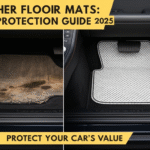Microfiber towels have changed how we clean, dry, and maintain everything from cars to kitchen counters. These synthetic wonders outperform traditional cotton towels in almost every category that matters. But here’s the thing – not all microfiber towels work the same way.
The secret lies in understanding GSM ratings, weave patterns, and matching the right towel to your specific needs. After five years of testing hundreds of microfiber products as a professional detailing specialist, I’ve learned that buying the wrong towel wastes money and delivers poor results.
Let me share what really matters when choosing microfiber towels that actually work.
What Makes Microfiber Towels Special
Microfiber consists of polyester and polyamide fibers split into strands 100 times thinner than human hair. This creates millions of tiny hooks and loops that grab dirt, dust, and moisture better than any natural fiber.
The polyester component handles oil and grease. The polyamide part attracts water and fine particles. Together, they create a cleaning powerhouse that works without chemicals in many cases.
Traditional cotton towels just push dirt around. Microfiber actually captures and holds contaminants until you rinse the towel. This fundamental difference explains why microfiber towels clean better and last longer.
Key Benefits of Quality Microfiber
Superior absorption: Good microfiber holds 7-8 times its weight in water. Premium versions can absorb even more.
Lint-free cleaning: Unlike cotton, microfiber won’t leave fibers on glass, screens, or polished surfaces.
Durability: Quality microfiber towels survive 300-500 wash cycles when cared for properly.
Chemical-free cleaning: The mechanical action of microfiber removes most dirt and bacteria without cleaning products.
Understanding GSM Ratings
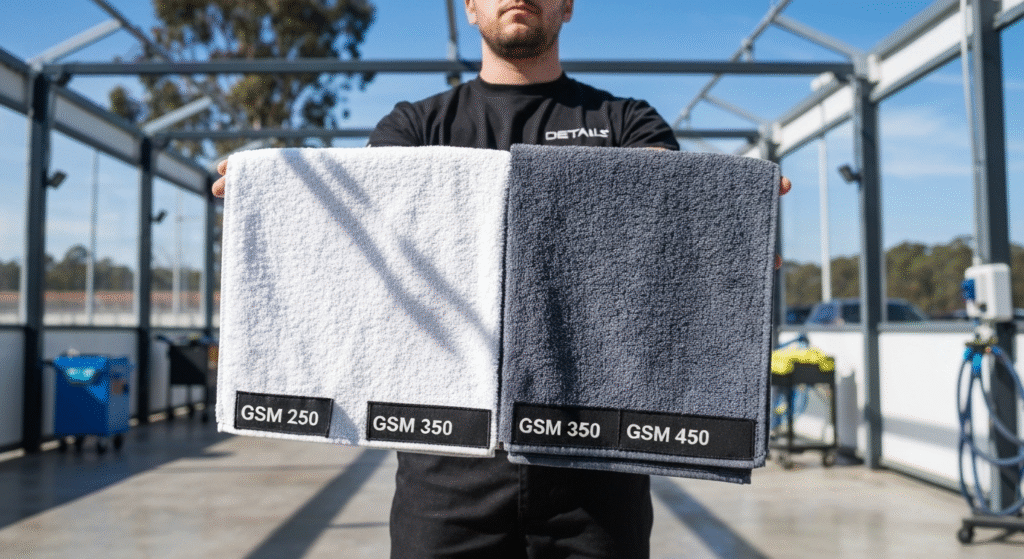
GSM stands for “grams per square meter” – it measures how much the fabric weighs per square meter. This number directly affects the towel’s thickness, absorbency, and best uses.
Here’s how different GSM ratings perform in real-world applications:
GSM RangeThicknessBest UsesProsCons200-300ThinGlass, screens, light dustingQuick drying, streak-freeLow absorbency300-400MediumGeneral cleaning, kitchen workBalanced performanceAverage durability400-500ThickCar drying, heavy cleaningHigh absorbency, durableSlower drying500+Very ThickPremium detailing, delicate surfacesMaximum performanceExpensive
My Experience with Different GSM Levels
I use 250 GSM towels for final glass cleaning on car windshields. They leave zero streaks and work perfectly with glass cleaners. For drying cars after washing, I reach for 400-450 GSM towels that soak up water quickly without scratching paint.
The 600 GSM towels I bought for premium detailing work amazingly well but take forever to dry. They’re worth it for show cars but overkill for daily cleaning tasks.
Pro tip: Match GSM to your specific job. Higher isn’t always better if it doesn’t fit your needs.
Weave Patterns That Matter
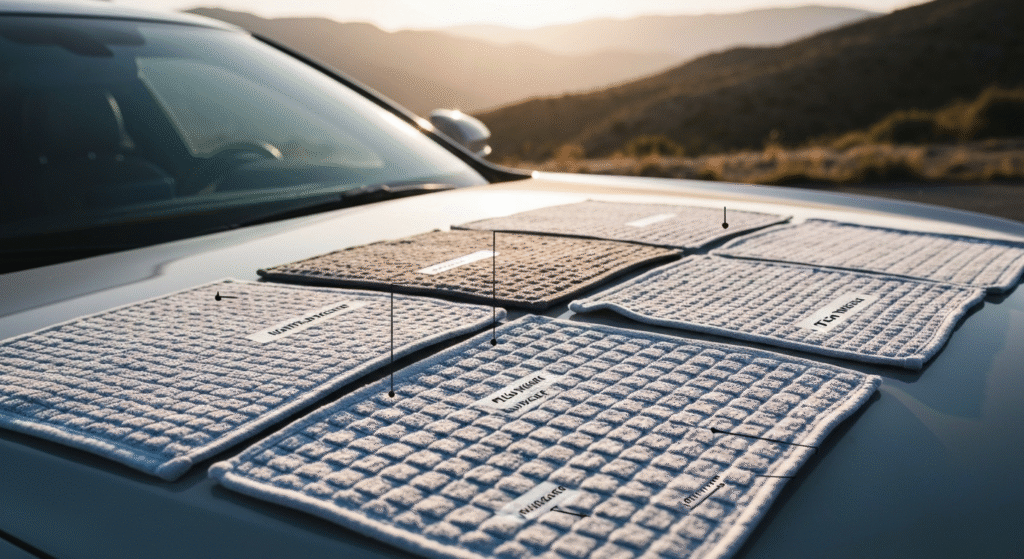
The way microfiber gets woven affects how it performs. Different weave patterns excel at different tasks.
Waffle Weave
Creates a textured surface with raised squares. The pattern increases surface area and creates air pockets for better absorption.
Best for: Drying cars, absorbing spills, general-purpose cleaning Why it works: The texture traps water and debris effectively while the air pockets increase capacity
Plush Weave
Produces a soft, dense surface similar to velvet. The fibers stand upright, creating a gentle cleaning surface.
Best for: Delicate surfaces, polishing, final detailing work Why it works: Soft fibers won’t scratch while still providing good cleaning action
Terry Weave
Features loops like traditional terry cloth but made from microfiber. Combines familiar feel with microfiber performance.
Best for: General household cleaning, bathrooms, kitchen work Why it works: Loops create more surface area while maintaining durability
Flat Weave
Smooth, tight weave with minimal texture. Creates the most lint-free surface.
Best for: Glass, screens, optical equipment, precision cleaning Why it works: Smooth surface won’t streak while microfiber properties still attract particles
Choosing the Right Microfiber Towel
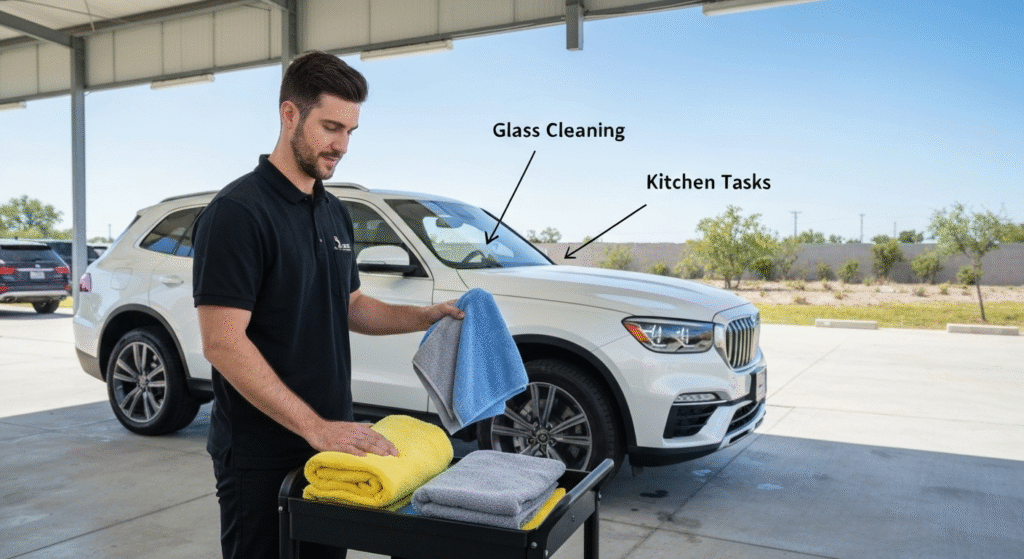
Your intended use should drive every buying decision. Here’s my systematic approach to matching towels with tasks:
For Car Care
Washing: 300-350 GSM waffle weave towels work best. They hold soap solution well and rinse clean easily.
Drying: 400-450 GSM waffle weave provides maximum absorption. I use two towels – one for initial drying, another for final touches.
Interior cleaning: 250-300 GSM plush weave handles dashboards and upholstery without scratching delicate surfaces.
Glass cleaning: 200-250 GSM flat weave eliminates streaks better than any other option.
For Home Cleaning
Kitchen counters: 300-350 GSM terry weave balances absorption with quick cleaning action.
Bathroom surfaces: 350-400 GSM waffle weave handles water spots and soap scum effectively.
Dusting furniture: 250 GSM plush weave attracts dust without scratching wood finishes.
Floor cleaning: 400+ GSM terry weave for wet mopping, 300 GSM flat weave for dry dust mopping.
Quality Indicators to Look For
After testing hundreds of microfiber towels, I’ve learned to spot quality before buying.
Fiber Split Quality
Run your hand across the towel. Quality microfiber feels slightly rough – that’s the split fibers catching on your skin. Smooth microfiber hasn’t been properly split and won’t clean effectively.
Edge Construction
Look for sewn or serged edges. Cheap towels use chemical-cut edges that fray quickly and can scratch surfaces.
Blend Ratio
The best towels use 80% polyester and 20% polyamide. Some manufacturers print this on labels, but many don’t. Quality brands always maintain proper ratios.
Color Considerations
Darker colors hide stains but may bleed when new. Light colors show dirt better for cleaning tasks. I use different colors for different jobs – blue for glass, gray for general cleaning, yellow for kitchen work.
Common Buying Mistakes to Avoid
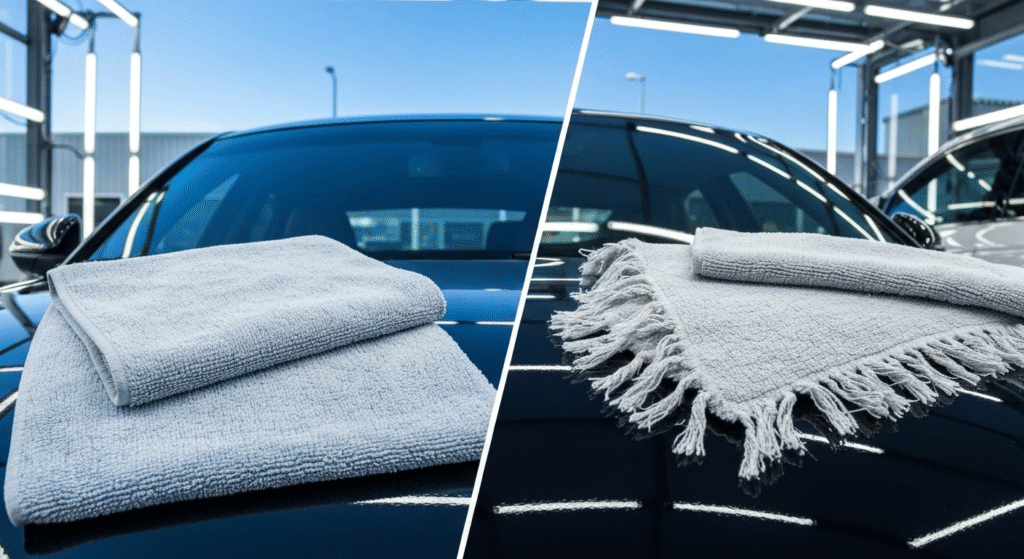
Focusing Only on Price
Cheap microfiber towels often use poor-quality fibers or improper blends. They fall apart quickly and don’t clean well. I’ve learned that spending $3-5 per towel for quality saves money over time.
Ignoring Care Requirements
Some towels need special washing instructions. Heat-sensitive towels won’t survive normal dryer cycles. Always check care labels before buying.
Wrong Size Selection
Huge towels seem like good value but become unwieldy for detailed work. Small towels dry out too quickly for large surfaces. I prefer 16×16 inch towels for most tasks.
Buying Single-Purpose Towels
Marketing often pushes specialized towels for every task. In reality, a few quality towels in different GSM ratings handle most jobs better than a dozen specialized ones.
Proper Care and Maintenance
Quality microfiber towels last years when properly maintained. Here’s my proven care routine:
Washing Guidelines
- Separate microfiber from cotton and other fabrics
- Use liquid detergent without fabric softener
- Wash in warm water (not hot)
- Skip bleach and fabric softener completely
Drying Best Practices
- Low heat setting or air dry
- Remove while slightly damp to prevent over-drying
- Don’t mix with cotton items in the dryer
Storage Tips
Store clean, dry towels in breathable containers. Plastic bags trap moisture and create odors. I use mesh laundry bags for organization.
Frequently Asked Questions
Q: How long do quality microfiber towels last? A: With proper care, good microfiber towels survive 300-500 wash cycles. That translates to 2-5 years of regular use depending on frequency and care.
Q: Can I use fabric softener on microfiber towels? A: Never use fabric softener. It coats the fibers and destroys their ability to attract dirt and moisture. This ruins the towel permanently.
Q: What’s the difference between automotive and household microfiber? A: Automotive microfiber typically uses tighter quality control and softer fibers to prevent scratching paint. Household versions may use slightly coarser fibers that clean better but could scratch delicate surfaces.
Q: Why do some microfiber towels streak glass while others don’t? A: Streaking comes from poor fiber splitting, wrong weave pattern, or contamination from fabric softener. Quality flat-weave towels with properly split fibers never streak when clean.
Making Your Final Decision
The right microfiber towel depends on your specific needs, budget, and quality expectations. Start with one quality towel in the appropriate GSM range for your main use. Test its performance before buying more.
My current go-to setup includes:
- 250 GSM flat weave for glass (4 towels)
- 350 GSM waffle weave for general cleaning (6 towels)
- 450 GSM waffle weave for drying tasks (4 towels)
This combination handles 90% of my cleaning needs without requiring specialized towels for every task.
Quality microfiber towels transform your cleaning routine. They work better, last longer, and often eliminate the need for chemical cleaners. The upfront investment pays for itself through superior performance and durability.
Understanding GSM ratings, weave patterns, and proper selection criteria ensures you buy towels that actually deliver professional results. Skip the guesswork and choose microfiber towels based on science, not marketing claims.



